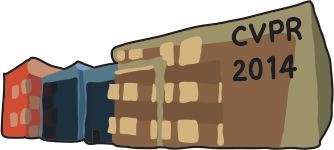-
Shrinkage Fields for Effective Image Restoration
AbstractMany state-of-the-art image restoration approaches do not scale well to larger images, such as megapixel images common in the consumer segment. Computationally expensive optimization is often the culprit. While efficient alternatives exist, they have not reached the same level of image quality. The goal of this paper is to develop an effective approach to image restoration that offers both computational efficiency and high restoration quality. To that end we propose shrinkage fields, a random field-based architecture that combines the image model and the optimization algorithm in a single unit. The underlying shrinkage operation bears connections to wavelet approaches, but is used here in a random field context. Computational efficiency is achieved by construction through the use of convolution and DFT as the core components; high restoration quality is attained through loss-based training of all model parameters and the use of a cascade architecture. Unlike heavily engineered solutions, our learning approach can be adapted easily to different trade-offs between efficiency and image quality. We demonstrate state-of-the-art restoration results with high levels of computational efficiency, and significant speedup potential through inherent parallelism.
Related Material
[pdf][bibtex]@InProceedings{Schmidt_2014_CVPR,
author = {Schmidt, Uwe and Roth, Stefan},
title = {Shrinkage Fields for Effective Image Restoration},
booktitle = {Proceedings of the IEEE Conference on Computer Vision and Pattern Recognition (CVPR)},
month = {June},
year = {2014}
}
These CVPR 2014 papers are the Open Access versions, provided by the Computer Vision Foundation.
Except for the watermark, they are identical to the accepted versions; the final published version of the proceedings is available on IEEE Xplore.
Except for the watermark, they are identical to the accepted versions; the final published version of the proceedings is available on IEEE Xplore.
This material is presented to ensure timely dissemination of scholarly and technical work.
Copyright and all rights therein are retained by authors or by other copyright holders.
All persons copying this information are expected to adhere to the terms and constraints invoked by each author's copyright.

